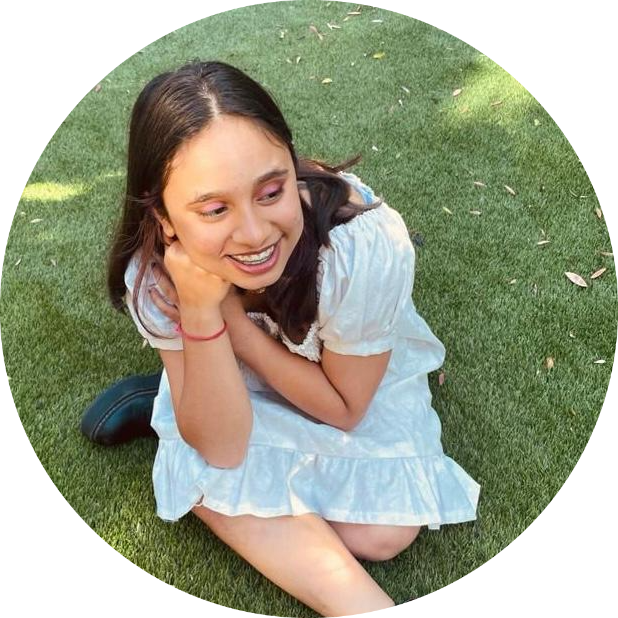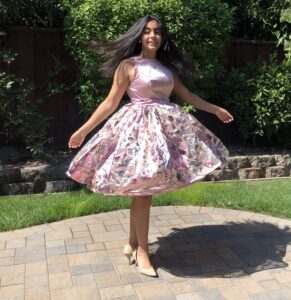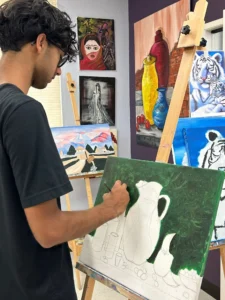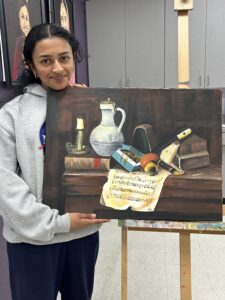“A Lonely Storm”
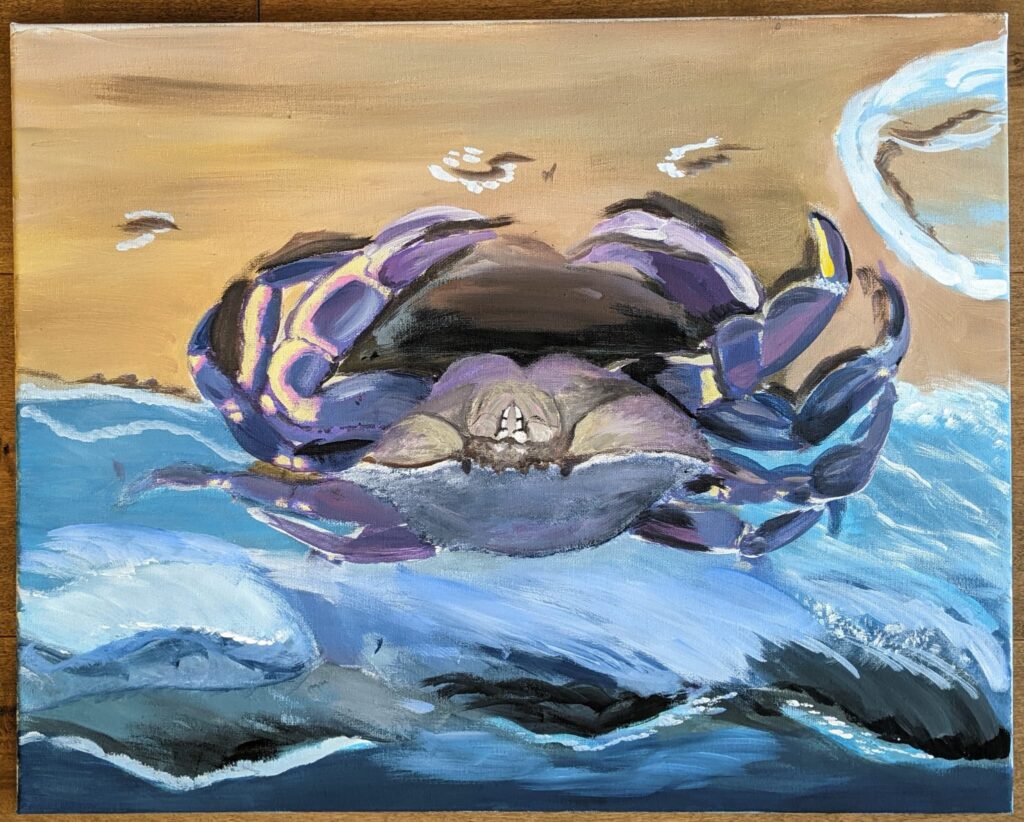
By Zoya Zafer (7th) The Journey of the Graceful Rock Crab The slender crab, also called the graceful rock crab, has a few different names. Its scientific names are Metacarcinus gracilis (used by WoRMS) and Cancer gracilis (used by ITIS). You can find this crab in places like Prince William Sound, Alaska, Sebastian Vizcaino Bay, Baja California, and Mexico. It has a rare purple color and is sometimes found in bays, but other times, it lives deep in the sand and mud—as deep as 174 meters! I chose to paint this crab because I love its purple shade. In my artwork, the crab is standing on a beach with big waves crashing behind it. The white lines show the foam that forms in the ocean during a storm. The dark blue, black, and white colors in the background make the storm feel intense and powerful. But even with the storm around it, the crab stays strong. I added yellow and pink on its legs to show how special this crab is. It stands in the middle of the painting to show that it is independent and brave. Even when it’s alone, it is still part of its graceful rock crab family. No matter where it is, it belongs. This artwork tells a story—even when things get tough, you can keep going and get through it. #RockCrab #MetacarcinusGracilis #ArtAndNature #StormySeas #StayStrong #KalaArtAndDesign
The Story of an Albacore
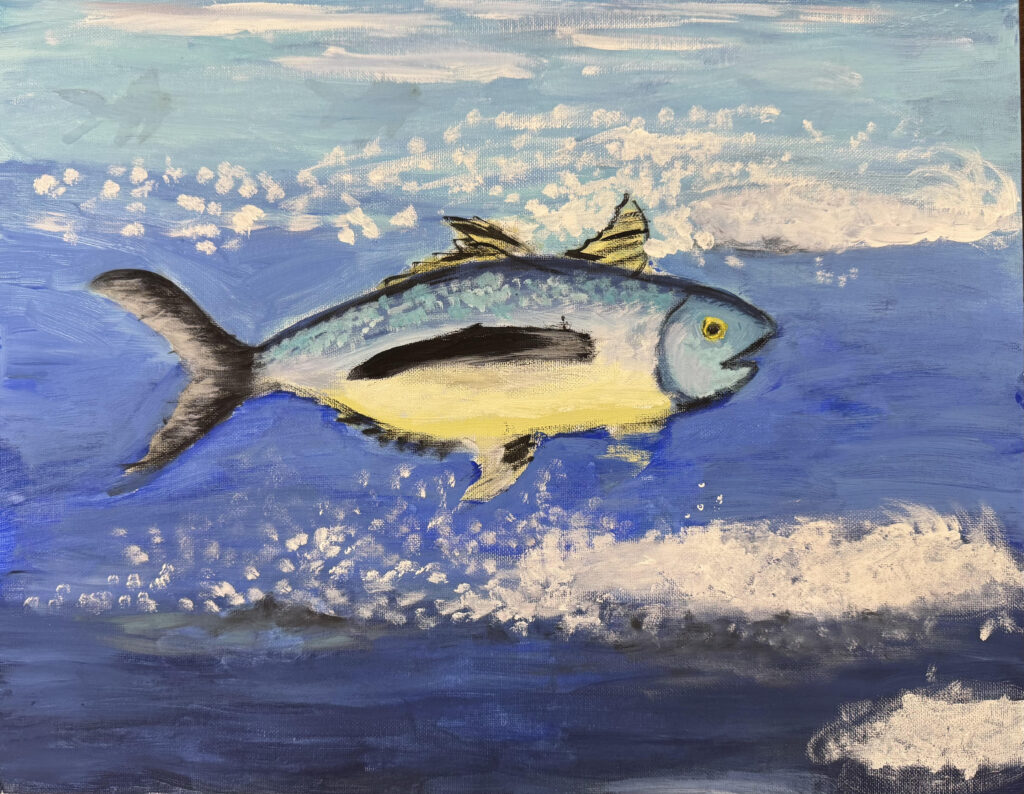
By- Gianna Joe Thoms Grade 2nd I made a painting of an albacore tuna swimming in my Kalaa Art & Design Studio. The fish is silver with a dark blue back. It has long fins that help it move fast through the water. I used different shades of blue to show how deep the ocean is. The top of the ocean is bright blue and the bottom is dark blue. Light shines through the waves, making the fish sparkle. The tuna looks smooth and shiny, like it is really swimming. Tiny bubbles float behind the tuna as it moves. In the background, there might be other sea creatures. Maybe there are little fish swimming nearby or a big shark far away. The water looks like it’s moving with soft waves. The painting shows how the ocean is full of life. The painting makes me feel like I am in the ocean swimming next to the fish. The colors are bright and pretty. The fish looks strong and free moving fast through the deep blue water. The ocean is big and full of amazing creatures. This painting shows how beautiful and special the albacore tuna is. It is a wonderful fish that belongs in the wild sea!
Truly magnificent; Tiger Rockfish
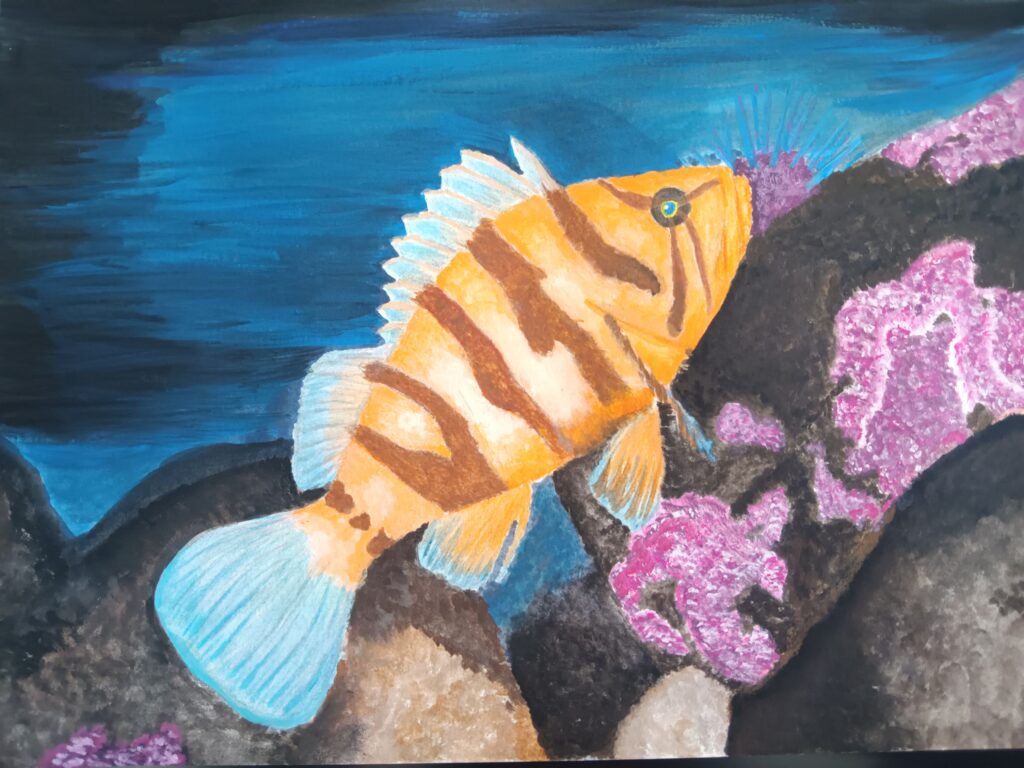
Rianna Shah Grade:8 The ocean is full of incredible creatures, but the tiger rockfish stands out as one of the most beautiful. The vibrant orange and brown stripes make the fish look fierce and elegant. Not only the fish but, its habitat is also just as beautiful, such as the vibrant and rocky reefs. In my artwork, I depicted this by portraying the dark rocks in the background of the fish, along with showing off the vibrant pink plantation around the fish. As I was selecting my artwork for this piece, I wanted a fish that was not only visually stunning but also unique, and the tiger rockfish was the perfect choice. I tried to capture its beauty by showing off the bold brown stripes and elegant orange body. This fish doesn’t blend into its surroundings as its vivid color scheme makes this fish stand out. The fins and spine on this fish, make the rockfish look truly majestic as it glides through the ocean floor. I love how the ocean is dark yet vibrant where this fish lives, and I displayed this stunning scene with a blend of black and blue paint. The Tiger Rockfish is truly magnificent, not just its beauty but also its gorgeous habitat in which it lives. This fish was truly an inspiration for me to paint, and through my art, I hope to capture the uniqueness of this exquisite fish. The world is full of beautiful creatures however, the tiger rockfish will always be one of the most beautiful. Inspiration : Ocean Light.com
Mist of Blue
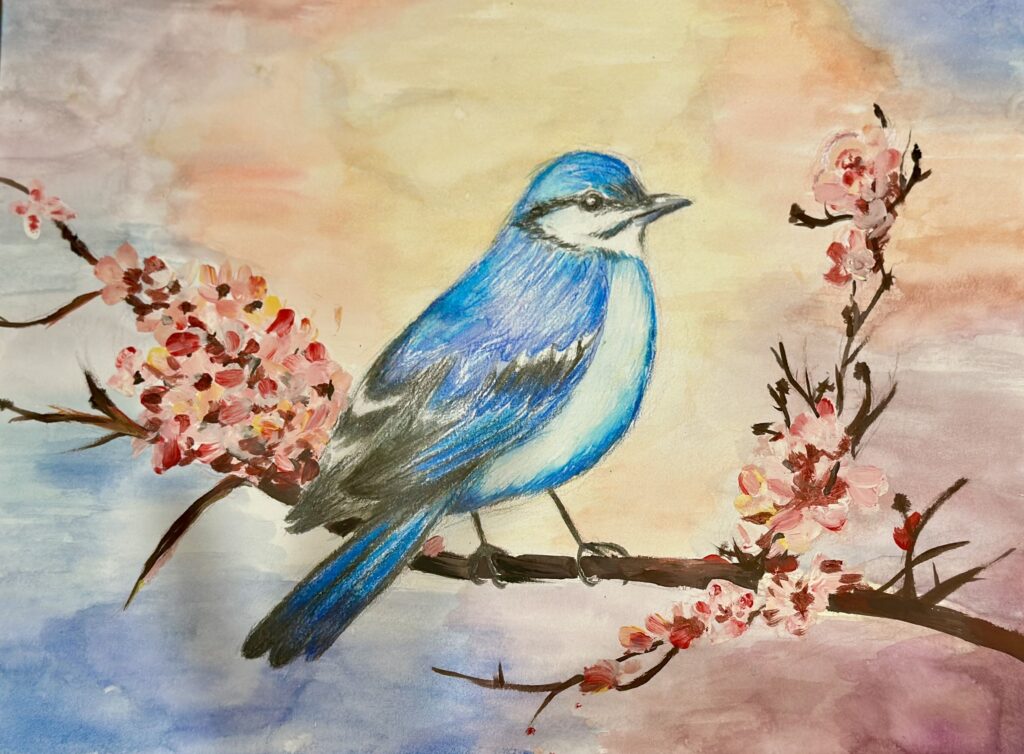
Anika Shiroor; 8th Grade, Dublin, Ca. “When as if by a call from above it is stirred, We hear the surge of its spiraling trill. And amisting of blue that seeps from its soul, It is the last of a kind, and unbowed”(Francis Stella). Thispoem is describing the luxurious Cerulean Warbler with its spiraling trill and the misting blue is of itsbluish color. From inspiring poets to being a symbol of beauty, freedom and spiritual growth,Cerulean Warbler is one of America’s favorite songbirds.Cerulean Warblers are found in the Americas. They usually breed in thick forests or in mountains likethe Appalachian Mountains and the northern Andes where they usually make their nests. When theymigrate, these birds like tropical forests or brush. During the winter they rest in the forests andmountains. The male Cerulean Warbler has a cerulean neck with the same color down its sides.Females are a similar but more dusky green color mixed with the cerulean. According to nps.gov,“The Cerulean Warbler is important to the ecosystem because they eat insects which can beconsidered as forest pests. By the removal of some forest pests like the cankerworm, caterpillarsand moth species”. Their diet mainly consists of insects found in their habitat. The population ofCerulean Warblers has actually declined, “by an estimated 1.84% per year between 1966 and 2019(amounting to a cumulative decline of 63% over that period), according to the North AmericanBreeding Bird Survey” allaboutbirds.org claims.These species represent a lot of things that are important to the human growth of having a bettermindset. Cerulean Warblers, and Warblers in general, symbolize a deep meaning for peace,optimism, and the cycles of life, inspiring an appreciation for the better part of life. A warbler issomeone who warbles. A warble is singing softly while changing notes such as a trill or tweet. Mostof the time this word identifies or relates to a bird therefore giving the name warbler. The first part ofthe name comes from its beautiful tealish coat. Apart from its spiritual importance it also has aphysical importance. Because of their diet they actually also manage to keep their forest clean. Thisbird actually gets rid of forest pests and doesnt let them overpopulate. This is important to theecosystem because if those insects did overpopulate they would cause a decline in other species.It was easy to choose this bird for my art submission since the bird’s natural colors are fantastic. Ihave used acrylic for the flowers because I believe that they were also an important part of thepiece.Since I am a beginner in watercolors, especially applying them in small areas, I have used it topractice the coloring and brush techniques. Through applying and controlling water usage in thebackground, I learnt how to remove water spots efficiently. I believe that the blue contrasted with thebackground made the bird stand out more. Since orange is on the opposite side of the color wheel ofblue it worked perfectly. I also fell in love with the original paint scaping of the reference image. Thissummarizes why I chose to do this bird and the beauty and the facts behind it.The Cerulean Warbler symbolizes endurance and patience. The same can be said of art. Unless itendures hard work with patience, the beauty does not reflect for the world to see. For a little bird thatsings joyous songs, this bird takes on an extremely challenging migration from north to south andreminds us, to perfect in the same way our own art. Sources: allaboutbirds.org, nps.gov, massaudubon.org, birdtipper.com
Song of the Sky by Vihaan Shiroor
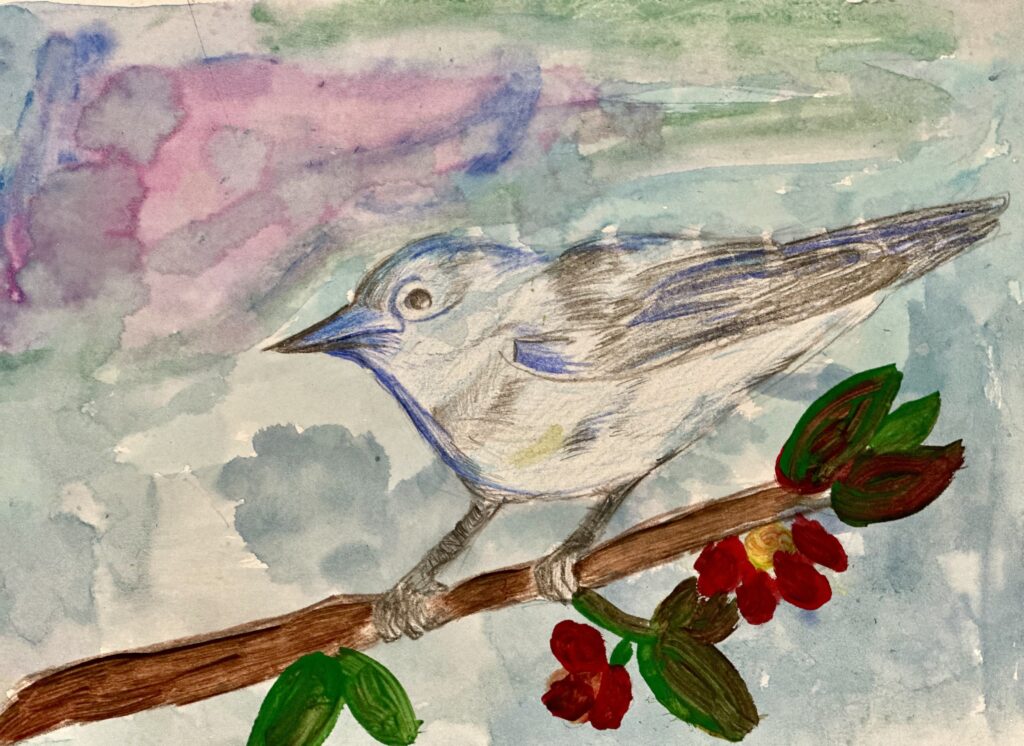
Song of the Sky-Vihaan ShiroorGrade: 4thDublin, California Cerulean Warbler is a songbird known for its blue hues and rapid, buzzy songs. It is a small bird found in the eastern United States which migrates to warm parts of South America during winter. They love to nest in tall trees in hills or mountains and primarily eat insects. It was Ms. Nidhi, who is my art teacher, told us about the Songbird Art Contest in one of our classes. I was excited to work on my next piece especially since I could pick one of the birds from the list. We had five birds to choose from and I decided to pick Cerulean Warbler. At first I just liked the color of the bird but then I researched a little bit about it and learnt some details about the bird. That made me further like this bird. Do you know that Cerulean Warbler is on the U.S Fish and Wildlife Service’s Birds of Conservation list? They have become endangered primarily because their habitats and nesting grounds have reduced due to deforestation in the United States, South America and all along their migration path. This little songbird’s declining population is causing imbalance in forest ecosystems where they reside and eat pests like caterpillars, moths and cankerworms. A small bird that can hardly be a threat to anyone is being greatly harmed as deforestation is expanding due to human activities. Reading this made me a bit sad and I decided to make a painting of this bird. I have used watercolor and colored-pencils to enhance the artwork. I have tried to use watercolor in the background and that was difficult since the amount of water needs to be controlled. But I am happy with the experiment since it made me learn something new. My awareness about Cerulean Warbler was raised due to my participation in this contest. I am hoping that my painting will try to raise awareness about this bird among my friends and family members. Human activities have long interfered with nature and innocent creatures are getting impacted. We still have time to save some of these endangered species and I hope we all can come together in this effort.
Radha-Krishna: The Colors of Divinity
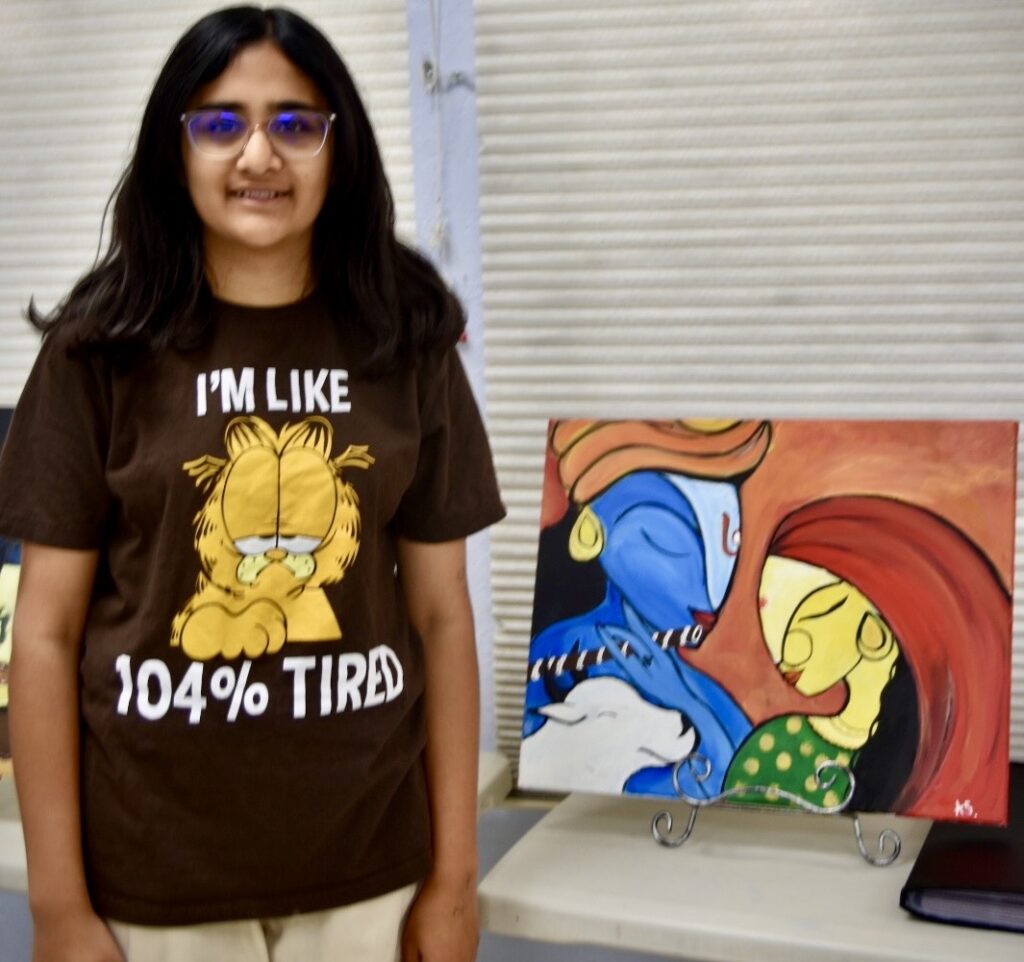
By- Anika Shiroor, 8th Grade During this past summer holiday, our art school was deciding projects for all of us. I was given a watercolor landscape village project by Ms Nidhi and it did not excite me since I had drawn landscape scenes multiple times before. So I asked her if I could do a canvas painting instead and she agreed on the condition that I pick a subject related to my culture. I decided to go with the Radha Krishna theme from among the many options she gave me. I thought it was the prettiest of the lot. For this artwork, I first drew out a sketch to my liking. I altered the original piece as per my artistic vision. I discussed this with Ms Nidhi and then changed the skintone to blue and yellow to show that it was Krishna and Radha. Colour plays a significant role in art, and it holds even deeper meanings in the context of Hindu spiritual and cultural depictions. Traditionally Krishna is depicted in blue, The Color of Divinity. Blue Color distinguishes God from mere humans. the colour blue carries profound symbolic meaning. It is associated with divinity, transcendence, and the infinite. It represents the vastness of the sky, the depths of the ocean, and the boundless expanse of the universe and at the same time depicts calmness, serenity, and tranquillity. Radha is supposed to be very fair in comparison so I changed Radha’s skin color to contrast Krishna’s. I have used acrylic paints in this painting. Yellow is often associated with sunshine, warmth, and the vibrant energy of life. Radha is symbol of It represents optimism, happiness, and radiance. To make it fit into the contemporary style with abstract elements, Ms Nidhi sugggested to make the eyes long and prominent. We decided to keep the eyes in the painting closed showing clamness. The calf was not in the original picture. I added a calf because in the traditional stories, Krishna is a cow herder and adding this to the painting made it complete. Since the design was too plain, we added decorations to the garment and flute. The background is a contrast to make the characters pop. It was a difficult piece because the surfaces had to be smooth with every brush stroke. It took me around a couple of classes to do it because I kept removing features with new ones. The final painting shows us Krishna playing the flute while Radha and the calf are listening and enjoying the tune that he is playing. Growing up, I have heard many stories of the iconic duo, Radha and Krishna. They are told to be the greatest of friends. She is his greatest companion in Vrindavan and their relationship symbolizes unconditional love. Growing up with these stories have had an effect on me. Therefore this painting means a lot to me.Exploring the symbolism of colours in Krishna paintings allowed me to appreciate the thoughtfulness and intention behind the portrayal of this divine figure. I am proud of this work and would like to make more paintings on this theme in different genres.
The healing power of art

“The arts are a critical component of healthcare. Expressive art is a tool to explore, develop, and practice creativity as a means to wellness.” ~ Wellarts Association ART has the power to heal, inspire, provoke, challenge & offer hope. ART enhances individuals, society, and the environment. Decades of research have provided more than a sufficient amount of data to prove that arts education impacts everything from overall academic achievement to social and emotional development and so much more. Research has proven the arts develop neural systems that produce a broad spectrum of benefits ranging from fine motor skills to creativity and improved emotional balance Every time you engage in a new or complex activity, your brain creates new connections between brain cells. Your brain’s ability to grow connections and change throughout your lifetime is called brain plasticity or neuroplasticity. Creating art stimulates communication between various parts of the brain. And this is the mere reason why art is important in our daily lives. Art and design process makes life worthwhile. It may not be vital to fulfill our basic needs, but it does make life joyful.
Harmonious Canvas’ Fusion of My Passions
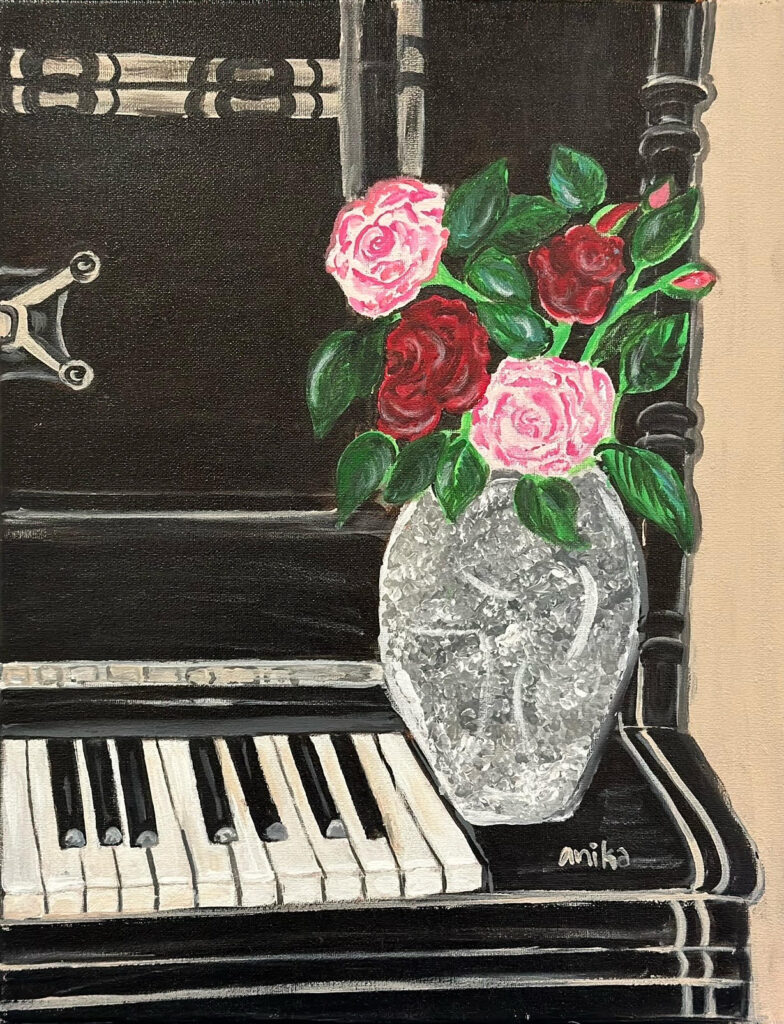
By- Anika Shiroor, 7th grade There are two major influences in my life which started early on – art and piano. For this blog, I want to present Piano, Still-Art on canvas which I painted in 2020. Not only was this the first canvas I painted, but this was also the piece where both my passions intersected. Ever since I was a little girl, I remember my fascination for drawing. I would fill pages and pages in books or draw on boards in my room. I would draw and write stories to express myself. I had a couple of friends who were interested in art, just like me and we would collaborate on stories with art together. I have lost a lot of that work but some of them were preserved by my mom as digital memories on Instagram and Youtube. When I turned five, my parents enrolled me in piano lessons which were super fun thanks to my teacher, Ms. Elena. She made piano effortless and with time I prepared for the Certificate of Merit exams that are held every year by the Music Teachers’ Association of California with her help. I completed level 5 this year. These creative fields have impacted me immensely and both piano and art hold a special place in my heart. In my opinion, these are the nicest ways to express yourself. In 2020, my art teacher, Ms Nidhi announced that we were ready to paint our first canvas art. When I heard that we could choose our own subject I immediately went online to find ideas. While searching for ideas I came across this piano painting online. I knew right then, that I would do this painting because of my love for the piano. This canvas painting combines the luxury of a piano with the beauty of roses. Even though it was a little tough for me back then, I discussed it with my teacher and set on to do this piece. This artwork was created with acrylic paints over a span of a few weeks. I first had to sketch it out and practice it in my art book to ensure that I was familiar with everything in the painting. I made a lot of mistakes because this was my very first canvas painting. This was also my first attempt with acrylic paint. As I understood that all my mistakes in the painting could be covered up by adding more paint, I got impatient with the process. Very soon I realized, that this impatient mindset made my work even worse. With a lot of encouragement from my teacher and correction, I was finally able to complete this artwork. Of course, I was super happy with it as this was my first artwork on canvas even though it had a lot of corrections. The lesson that I learned was that the best results came out when I was patient with the process. I also realized that in my hurry to complete the work, I often rushed and that resulted in a lot of feedback from my teacher both in technique and finish. This canvas is presently hanging on my bedroom wall as a reminder of the process of learning and my continued efforts in art.
Warli Art: Indian Wedding Village Scene
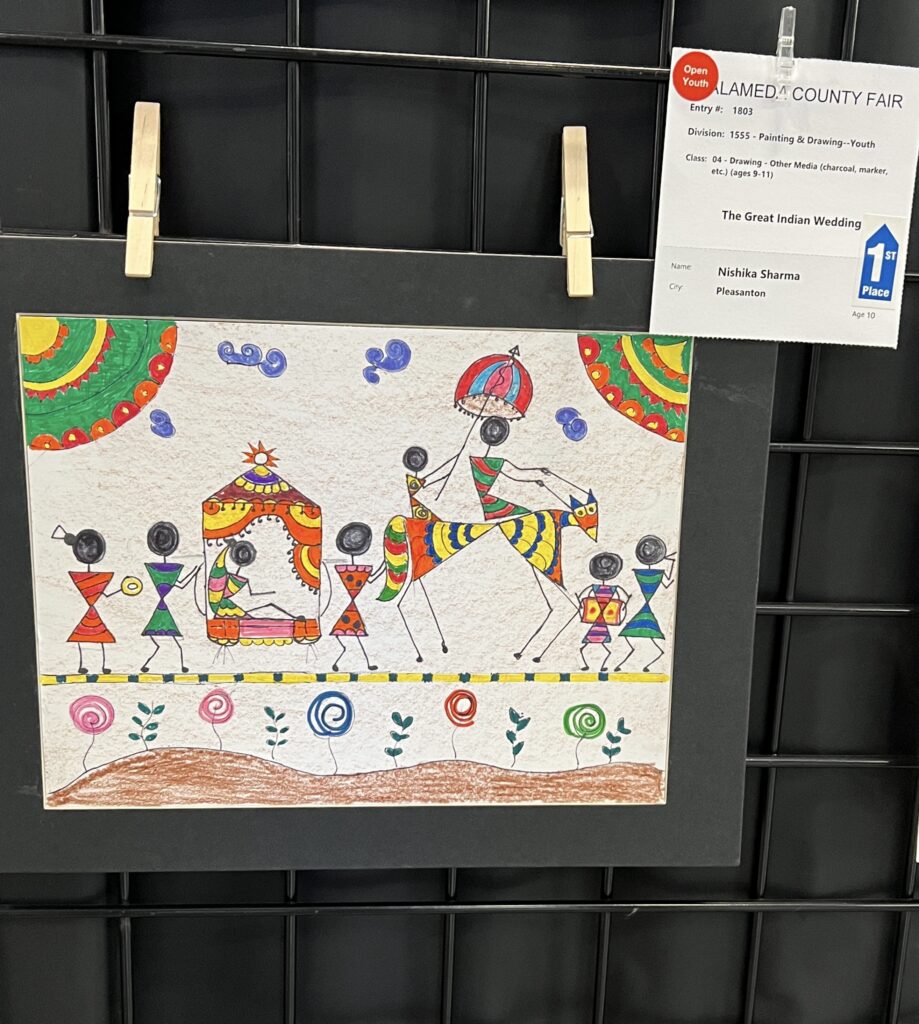
By Nishika Sharma, 7th Grade PleasantonOriginating from Maharashtra, a style of tribal, or folk, art, Warli art, is believed to be one of the oldest art forms of history and comes from one of the largest tribes of India, the Warli tribe. The culture of Warli art is centered around the concept of Mother Nature and elements of nature are often depicted in Warli paintings. If you’ve seen Warli art, you may have noticed the intricate geometric patterns that make this art style unique. These patterns are used to depict human figure, house and daily work like hunting, dancing, sewing, etc. However, the regular theme of Warli art is marriage and the unique aspect of these kinds of paintings is that it does not depict mythological characters or images of god and goddesses but depicts social life. Warli art can be done on anything from walls to purses and many other accessories or vehicles. Being of Indian American heritage, I have attended several Indian weddings and was always amazed by the colors and artistry used in these weddings. A famous fairgrounds know as The Alameda County Fair has been held in Pleasanton, CA since 1912, and my art teacher, Mrs. Nidhi suggested that I participate in the fine arts contest in the fair and do a piece on folk art. For this project, I looked at many reference images of different folk art scenes that Mrs. Nidhi showed to me, and the one depicting an Indian Wedding stood out to me the most because of the intricate dress patterns, the instruments, and all the other features in the piece. So, she told me to start with a rough draft and sketch the basic shapes such as circles, triangles, squares, etc. After getting basic shapes down the only thing left to do is add different geometric patterns on the dresses and different objects, like the palanquin and instruments, and then make it colorful. Since folk art is solely made of shapes, doing a rough sketch was simple, and I quickly moved on to the final draft where I traced everything with black, added some scenery, and washed the page with bright colors. Once I was happy with how the scene stood out, I showed it to Mrs. Nidhi and she told me I can submit it to the Alamenda County Fair. I submitted the work to compete in the Youth still exhibits category (paintings and drawings). Later, when the date came, I visited the fair with my family, had some fun, and made my way to the exhibit hall where I saw my art work displayed, and I was thrilled to see that I was awarded first place in the 9-11 year category. After going through this experience, I knew I wanted to continue submitting my art in this contest for years to come.


